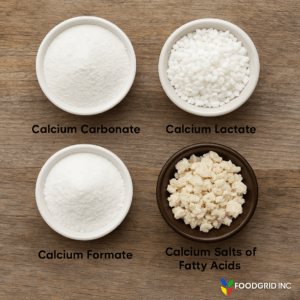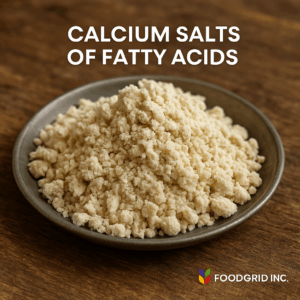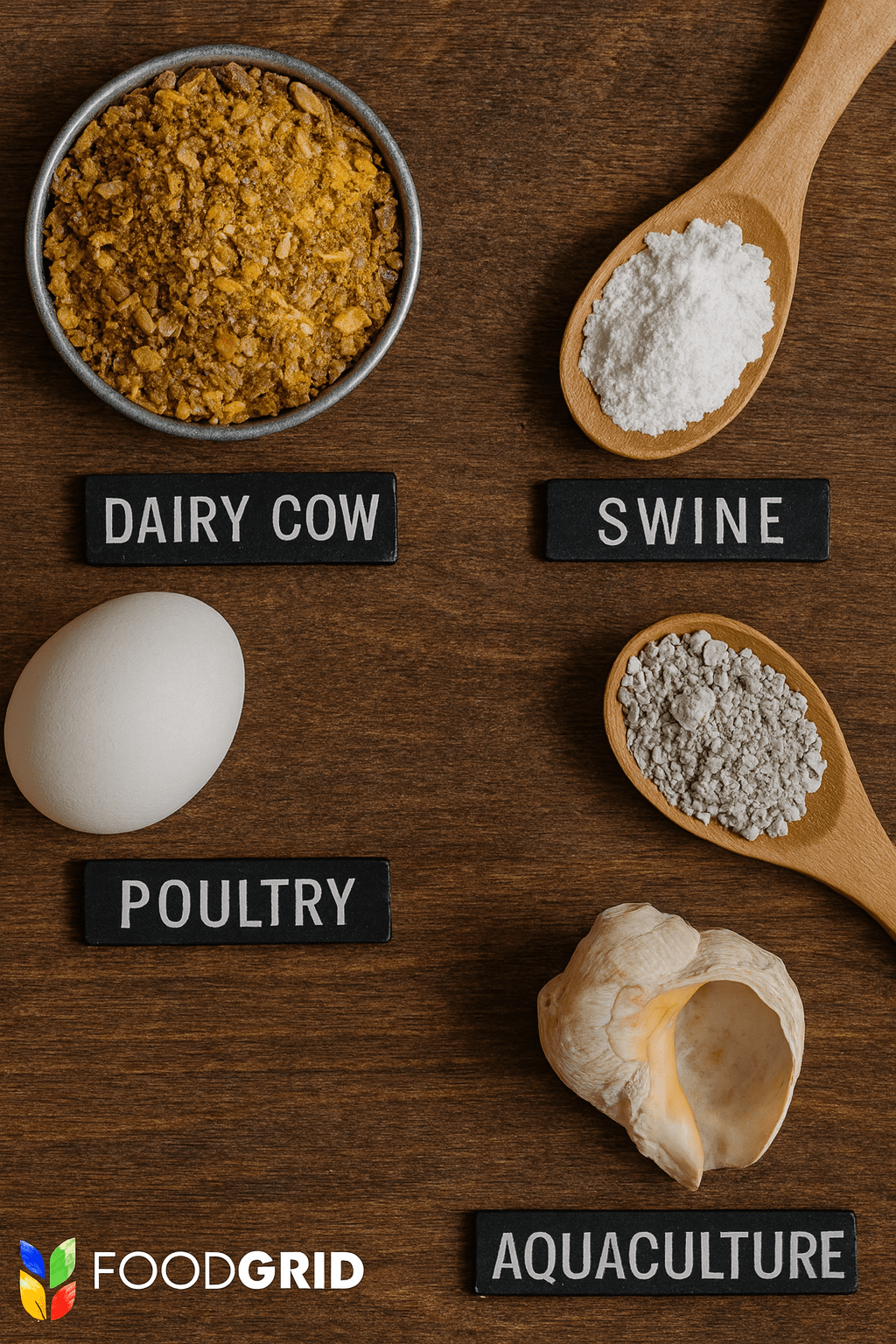Behind every liter of milk lies a science-driven formulation designed to balance nutrients, optimize yield, and sustain herd health. Among these nutrients, calcium salts stand out—not only for their role in skeletal development but also as catalysts of energy metabolism, rumen stability, and overall productivity.
For dairy producers navigating volatile feed costs, rising animal welfare expectations, and stricter regulatory frameworks, the strategic use of calcium is no longer optional. It is a core element of profitability and herd sustainability.
Why Calcium Matters in Dairy Nutrition
Calcium is one of the most abundant minerals in the cow’s body. Its roles extend far beyond “bone strength”—they are vital to every aspect of cow health and productivity:
Skeletal Framework: Roughly 99% of calcium resides in bones and teeth, ensuring structural strength for high-yielding dairy cows.
Neuromuscular Function: Calcium ions regulate muscle contraction, nerve transmission, and cow mobility.
Blood Clotting and Immunity: Adequate calcium is essential for normal clotting mechanisms and proper immune function.
Milk Secretion: Calcium is a critical component of milk. Inadequate supply directly limits yield and milk quality.
Without a balanced calcium intake, cows are vulnerable to hypocalcemia (milk fever), poor fertility, reduced milk production, and increased veterinary interventions.
Key Calcium Sources for Dairy Producers
1. Calcium Carbonate
Most common and cost-effective form.
Essential in preventing milk fever in transition cows.
Granulated forms improve handling and reduce dust in TMR mixing.
Micronized versions offer enhanced solubility for better absorption.
2. Calcium Lactate
More soluble than carbonate.
Suitable for situations requiring rapid calcium availability (e.g., stressed cows, younger heifers).
3. Calcium Salts of Fatty Acids (Bypass Fats)
Provide rumen-protected, concentrated energy and calcium.
Increase milk yield (+2–4 kg/day) and fat percentage (+0.5–0.8%).
Reduce negative energy balance in early lactation by bypassing rumen degradation.

Physiological Benefits for Dairy Cows
Prevention of Hypocalcemia
Transition cows require a surge in calcium at calving. Supplementing with calcium carbonate and calcium salts helps mitigate clinical and subclinical milk fever.
Improved Milk Yield and Butterfat
Calcium salts of fatty acids have been shown to significantly boost energy-corrected milk yield and butterfat, improving profitability.
Skeletal Strength
Consistent calcium supplementation ensures bone density and reduces metabolic stress.
Metabolic Efficiency
Supports enzymatic activity, energy metabolism, and reproductive health.
Feeding Strategies for Dairy Nutrition Partners
Balancing Calcium and Phosphorus
The Ca:P ratio in dairy diets should range from 1.5:1 to 2:1.
Over-supplementation of calcium can suppress phosphorus and zinc absorption, leading to deficiencies.
Precision formulation tools help balance these minerals accurately.
Targeted Supplementation
Transition cows: Use calcium carbonate in pre-fresh diets to control DCAD (dietary cation-anion difference). Introduce calcium salts of fatty acids post-fresh to provide energy and calcium simultaneously.
High-yielding lactating cows: Include 2–3% DM as calcium salts of fatty acids for milk yield and butterfat improvement.
Dry cows: Maintain controlled calcium levels with carbonate to prevent metabolic stress at calving.
Inclusion Guidelines
Transition cows: 100–150 g/day of calcium salts of fatty acids.
Lactating cows: 2–3% of dietary DM.
Monitoring: Track milk yield, butterfat %, and incidence of hypocalcemia to adjust supplementation.

Practical Considerations for Dairy Farm Owners & Managers
Particle Size and Flowability
Fine powders increase solubility but can create dust and handling issues.
Granulated or coated products reduce dust, improve flowability, and ensure accurate mixing.
Quality and Consistency
Variability in raw materials affects bioavailability. Reliable sourcing ensures stable performance.
Always prioritize GMP+ certified products for quality assurance.
Regulatory Compliance
EU-approved calcium sources (E170) are required for export markets.
Compliance ensures market access while reducing the risk of costly recalls.
Industry Trends Impacting Calcium Use
Sustainability: Higher bioavailability reduces waste output and environmental load.
Antibiotic-Free Production: Calcium salts of fatty acids support energy metabolism, reducing stress and health setbacks without antibiotics.
Precision Nutrition: Software modeling helps Ruminant Feed Specialists fine-tune Ca:P balance.
Global Dairy Growth: Demand for milk and dairy products continues to rise, pushing for more efficient feed additives.
Common Challenges and Solutions
1. Hypocalcemia in Transition Cows
Cause: Insufficient available calcium during calving.
Solution: Incorporate carbonate pre-fresh; calcium salts of fatty acids post-fresh.
2. Mineral Interactions
Cause: Excess calcium interfering with phosphorus.
Solution: Maintain correct Ca:P ratio with precise formulation.
3. Handling Issues
Cause: Dust and poor flowability in micronized forms.
Solution: Use granulated or coated calcium sources.
4. Feed Cost Pressures
Cause: Volatile feed and additive markets.
Solution: Invest in high-efficiency calcium salts to maximize ROI.
Economic ROI for Dairy Producers
Milk Yield Increase: +2–4 kg/day per cow.
Butterfat Premiums: +0.5–0.8% increase in fat = higher milk checks.
Health Cost Savings: Fewer metabolic disorders lower veterinary expenses.
Profitability: A 500-cow herd can gain $50,000–$70,000 annually from optimized calcium supplementation.
Supplier and Sourcing Insights
Preferred Suppliers: Trusted global providers such as Megalac and Valudor.
Purchase Formats: Palletized 1-ton lots for efficient delivery.
Buying Criteria: GMP+ certification, rumen stability, consistent particle size, proven ROI.
Internal Resources for Further Learning
- FoodGrid: Animal Feed Solutions → https://foodgridinc.com/
- FoodGrid Blog on Feed Innovations → https://foodgridinc.com/foodblog/
References
- University of Wisconsin–Madison Dairy Science
- Journal of Dairy Science – Calcium Salts Research
- USDA Economic Research Service
- FAO – Animal Production
Conclusion: Calcium Salts as a Competitive Edge
The integration of calcium salts into animal feeds is not just a nutritional necessity—it is a strategic advantage in modern livestock and aquaculture production. Whether through stronger eggshells, healthier piglets, or higher milk yield, calcium salts underpin both productivity and profitability.
With rising demand for meat, milk, and fish, and growing scrutiny on animal welfare, choosing the right form and formulation of calcium salts will separate high-performing producers from the rest.
👉 Explore scientifically backed calcium solutions at FoodGrid today: https://foodgridinc.com/
